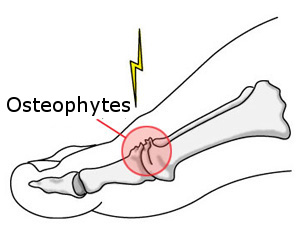Foot - hallux rigidus
What is hallux rigidus?
Hallux rigidus is osteoarthritis of the joint at the base of the big toe which joins the first metatarsal to the phalanges (toe bones) of the big toe. As with all joints, the ends of the bones in the foot are covered with articular cartilage which enables the bones to move smoothly during movement. If this surface becomes damaged, it starts to wear away until the bones become bare and rub against each other. As the bone becomes injured bone spurs (or osteophytes) may form around the joint which will limit the movement of your big toe – these often form on the top of the joint and can rub painfully against your shoe. The big toe will become increasingly stiff, making walking difficult.
What causes it?
There are various views regarding the causes of hallux rigidus. It may be the result of a previous injury (e.g. breaking or spraining the toe), although as it is a degenerative disease it may also occur through wear and tear. The structure of your foot may also mean that you are more likely to develop hallux rigidus as it will affect the way you walk, and the way pressure is distributed in the various joints of your foot.
How does it feel?
You will have pain in the big toe joint, which may worsen when you walk. It will be painful, or even impossible, to pull your big toe up towards you.
Diagnosis
A physical examination of your foot and the movement of the big toe should be enough to determine hallux rigidus, although your doctor will ask you for X-rays of the foot to determine the extent of the arthritic degeneration and the formation of bone spurs.
Treatment – conservative
Your doctor may prescribe chondro-protective medication (e.g. glucosamine, chondratin sulphate, or methyl methanesulfurnate), and anti-inflammatories. He may also inject hyaluronic acid into the joint, and manipulate the toe. In mild cases of hallux rigidus, these treatments, combined with special shoes or insoles to help you walk, may be sufficient.
Treatment – surgical
– Cheilectomy: your surgeon will make an incision at the base of the big toe, through which he will rub away the bone spurs that are limiting movement.
– Joint Arthroplasty: this procedure is performed to re-establish the correct amount of space between the bones of the joint so that it can move smoothly again. Your surgeon will make a small incision (5-6cms) on the side of the joint at the base of your big toe. He will remove the bone spurs, and then the diseased bone surface at the end of the phalanx (first bone of the big toe). A titanium button will be inserted into the cut surface of the phalanx so that it is the correct distance from the first metatarsal, which is held in place by a wire. Then the wound is closed. The wire will be removed after 3 weeks (it is completely painless), and the button will be removed in a small operation after 6 months when the bones have healed into the correct position.
– Arthrodesis or Fusion: in rare cases, the bones may be fused together i.e. allowed to grow together to form one bone. Your surgeon will make a small incision over the joint at the base of the big toe, and remove the ends of the two bones (first phalanx and metatarsal). The two cut surfaces will then be fixed together with pins, and the incision closed.
Rehabilitation after surgery
– Cheilectomy: you should be able to walk almost immediately after the operation wearing a special post-operative shoe that takes the pressure off the forefoot, although it may be more comfortable to use crutches for the first few days. You will be given exercises to manipulate the big toe, which are very important for regaining the movement in the toe.
– Joint Arthroplasty: you should be able to walk almost immediately after the operation wearing a special post-operative shoe that takes the pressure off the forefoot, although it may be more comfortable to use crutches for the first few days. Once the button has been removed you will be given exercises to manipulate the big toe.
– Fusion: you will need to walk with crutches for the first month while the bones heal together. You doctor will require X-rays of your foot to see how the bone is healing, and so you should bring these to your follow-up consultations.
When will I be back to normal?
– Cheilectomy: Office workers can return to work almost immediately, although manual workers will need to wait 10-14 days. You can drive after 10 days, and return to light sporting activity after a month.
– Joint Arthroplasty: you can go back to office work after a week, although manual workers should wait about a month. You can drive once the wire has been removed (3 weeks), and return to light sporting activity after a month.
– Fusion: the bones will take about 3 months to become totally solid, so care should be taken during this time. Office workers can go back to work after a week, and manual workers after at least 45 days, depending on their recovery. You can drive and do light sporting activity (swimming, cycling), but should wait 3 months before returning to high-impact sports.
